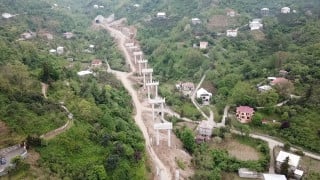The budget of the Ministry of Regional Development and Infrastructure for 2020 was GEL 2.071 billion. However, problems emerging as a result of the coronavirus pandemic necessitated a state budget revision. The 2020 anti-crisis budget was set at GEL 15,923,800,000. According to the updated 2020 state budget, the biggest cuts were made in the budget of the Ministry of Regional Development and Infrastructure. In particular, the funding was cut by GEL 251.3 million and decreased to GEL 1.820 billion. On 24 June 2020, the Parliament of Georgia adopted the anti-crisis budget with 84 MPs voting in favour.
FactCheck has already written about the state of infrastructure projects amid the pandemic (see FactCheck’s article). However, only the first quarter data of the ongoing year was available at the time of writing. As we know, the state of emergency in Georgia was declared on 21 March 2020 and the impact of the pandemic upon the implementation of infrastructural projects became more clear and evident based on second quarter data. Therefore, in order to assess the implementation of infrastructural projects amid the pandemic, FactCheck analysed the second quarter execution rates of the Ministry of Regional Development and Infrastructure’s budget as well as those of separate programmes and projects.
The second quarter spending plan of the Ministry of Regional Development and Infrastructure was GEL 774,161,000 whilst the execution figure was GEL 830,378,000. Therefore, the second quarter spending plan of the Ministry was executed by 107.2%.
Table 1: Budget Execution Rates of Certain Infrastructural Programmes Based on 2020 Second Quarter Data (GEL Million)
|
Programme Name |
Plan |
Fact |
Execution (%) |
|
Improvement of Road Infrastructure |
357.916 |
408.885 |
114 |
|
High-Speed Highway |
341.035 |
391.085 |
115 |
|
Restoration of Sewage Infrastructure |
71.616 |
77.54 |
108 |
|
Restoration of Regional and Municipal Infrastructure |
74.205 |
74.312 |
100.1 |
|
Solid Waste Management |
1.33 |
1.59 |
119 |
|
Rehabilitation of General Education Infrastructure |
664 |
306.592 |
46.2 |
Source: Treasury Service
According to the official data, the spending plan for all of the programmes run by the Ministry of Regional Development and Infrastructure was almost fully executed in excess. The only exception is the general education infrastructure rehabilitation programme which significantly lags behind and whose quarterly execution is less than half as compared to the planned amount. The second quarter budget execution performance of investment projects funded by donors through the 2020 state budget, such as the high-speed highway, was as follows:
Table 2: 2020 Second Quarter Budget Execution of Certain Sections of the High-Speed Highway (GEL Million)
|
Section |
Plan |
Fact |
Execution (%) |
|
Zemo Osiauri-Rikoti |
36.291 |
40.087 |
110 |
|
Batumi New Road |
35.339 |
39.557 |
112 |
|
Samtredia-Grigoleti |
34.485 |
34.408 |
99.7 |
|
Chumateleti-Khevi |
5.12 |
4.604 |
89.9 |
|
Khevi-Ubisa |
33.845 |
53.027 |
156.7 |
|
Ubisa-Shorapani |
52.62 |
52.484 |
99.7 |
|
Shorapani-Argveta |
102.773 |
124.068 |
120.7 |
|
Kvesheti-Kobi |
19.765 |
21.294 |
107.7 |
|
Zestaponi-Kutaisi-Argveta |
4.262 |
4.252 |
99.7 |
Source: Treasury Service
As the data show, the budgets for the construction of active sections of the high-speed highway are mostly executed in excess and only a few sections marginally lag behind.
When discussing the budget of the Ministry of Regional Development and Infrastructure, it is also important to consider the Regional Development Fund and the Mountain Settlement Development Fund’s budget execution figures:
Table 3: 2020 Second Quarter Budget Execution Rate of the Regional Development Fund and the Mountain Settlement Fund (GEL Million)
|
Fund |
Plan |
Fact |
Execution Rate (%) |
|
Regional Development Fund |
119.268 |
109.746 |
92.01 |
|
Mountain Settlement Development Fund |
5.005 |
2.455 |
49.05 |
Source: Treasury Service
According to the table, both funds are lagging behind in terms of budget execution whilst the Mountain Settlement Development Fund’s execution rate is less than half.
To summarise we can say that the Ministry of Regional Development and Infrastructure executed the second quarter budget spending plan in excess amid the pandemic (as mentioned previously, the Parliament of Georgia adopted the anti-crisis budget on 24 June 2020; therefore, the changes in the Ministry’s budget were not reflected in the second quarter). FactCheck only welcomes this fact although the memories of previous years, when large infrastructural projects (the construction of certain sections of the high-speed highway, especially the still unfinished Samtredia-Grigoleti section) were delayed and project completion deadlines were often violated, are still fresh (see article 1 and article 2). The high-speed highway’s final completion deadline has changed several times and was postponed to 2022 from the initially announced 2020.







